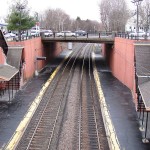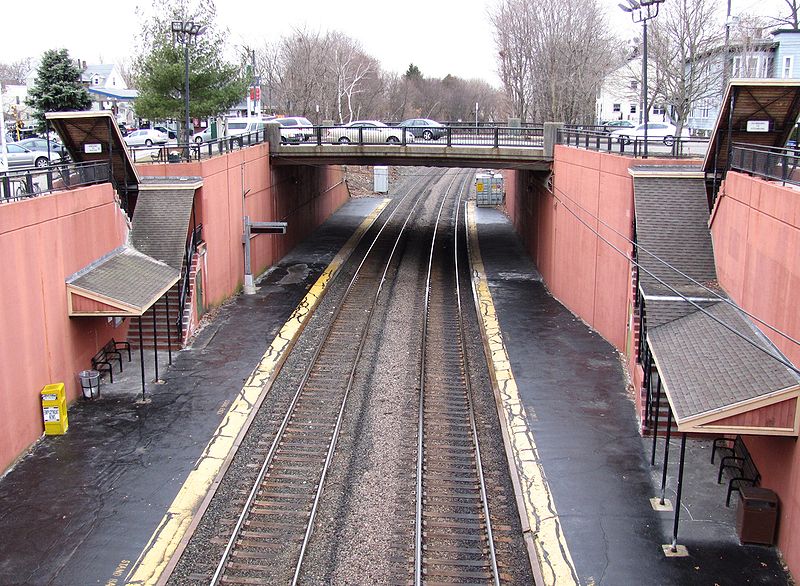
MBTA to hold November 16 Session on consolidating Waverley, Center stations
By Sue Bass
Should Belmont continue to have two commuter rail stations that people can walk to? Or is it better to have just one station with a parking garage that people can drive to? That’s not officially the topic of the MBTA commuter rail presentation on November 16, but it’s the question hovering over the event.
Formally, the meeting is about the T’s need to spend $15 million or more on a station that serves only 117 daily riders—or to close the station entirely. This issue arises because, several years ago, the MBTA spent $353,281 repaving the platform. That was more than 30% of the station’s value. In addition, the repaving did not raise the platforms to the level of the trains. Either violation alone—the spending or the failure to raise the platforms— required that the station be made accessible for handicapped people, with an elevator or ramps, according to the state’s Architectural Access Board. Appeals have failed. The conclusion seems unassailable—make it accessible or close it. (State Senator Will Brownsberger did what he called “a deep dive” on the issue, available at willbrownsberger.com/waverley-upgrade-obligation/.)
For the T, this situation either adds millions to its billion-dollar bill for system-wide repairs and upgrades—or it offers an opportunity to speed up commuter rail service on the Fitchburg line by eliminating a station that draws relatively few riders. In fact, it dangles the chance to replace two stations with low ridership by a single station in the middle, along south Pleasant Street, with a parking garage that could increase the total ridership. Daily ridership at the Belmont Center station was only 168 in April 2013, according to the latest data readily available, from the MBTA’s fascinating Ridership and Service Statistics, 2014, nicknamed the Blue Book, which is available at www.mbta.com/bluebook. The average for the Fitchburg line is 361 boardings per station
For Belmont, sadly, this situation threatens the loss of one or both walkable stations and their possible substitution by a new station to which few could walk—plus a garage that would draw even more traffic to Pleasant Street at rush hours, when it is already jammed.
It’s time for us to do what we do so badly and infrequently: try to look ahead and make wise choices about our future.
To start, why is ridership on the commuter rail so low? From Waverley, the train offers a trip of 10 minutes or less to Porter Square and 20 minutes or less to North Station in Boston. It’s two minutes quicker from Belmont Center.
Parking might be one reason. The MBTA’s Blue Book reports no auto spaces at Waverley, though there are 12 bicycle spaces. It reports 115 auto commuter spaces at Belmont Center, but in fact the police department’s traffic office says only 20 spaces are available, at $90 a month—and only a handful of those are spoken for.
Is the price too high, compared with parking downtown? Are people unaware that spaces are available? Would ridership go up if the long-discussed Community Path brings cyclists to the Waverley Square and Belmont Center train stations? Or is the commuter rail service too unreliable, or too infrequent? Do too few people work downtown these days?
Demographically, Belmont should be using more public transportation. “We’re seeing a general trend where the inner core—within [Route] 128—is growing faster than the outer suburbs,” said Eric Bourassa, transportation director for the Metropolitan Area Planning Council. “Part of it is because people do want to be closer to transit and commute in that way.”
Of course, Waverley Square has one of the busiest bus routes in the state, #73, with 6,424 daily boardings along the whole route and 753 at Waverley Station itself.
At the last meeting between MBTA officials and the Belmont Board of Selectmen, on September 28, T officials said part of the challenge in making the two Belmont stations accessible is that both are on curves. The bend in the tracks makes it much more difficult and more expensive to provide roll-on service to the trains. The straight track along Pleasant Street between Waverley and Belmont Center appealed to the T for that reason.
Several in the audience suggested that a small shift in the location of the stop—a dozen feet or so—might solve that problem, at least at Waverley. Is that true? Would other simple solutions shave millions off the price tags for making Waverley accessible? It’s time to find out.
—Sue Bass is director emerita of the Belmont Citizens Forum.



Sorry, the comment form is closed at this time.